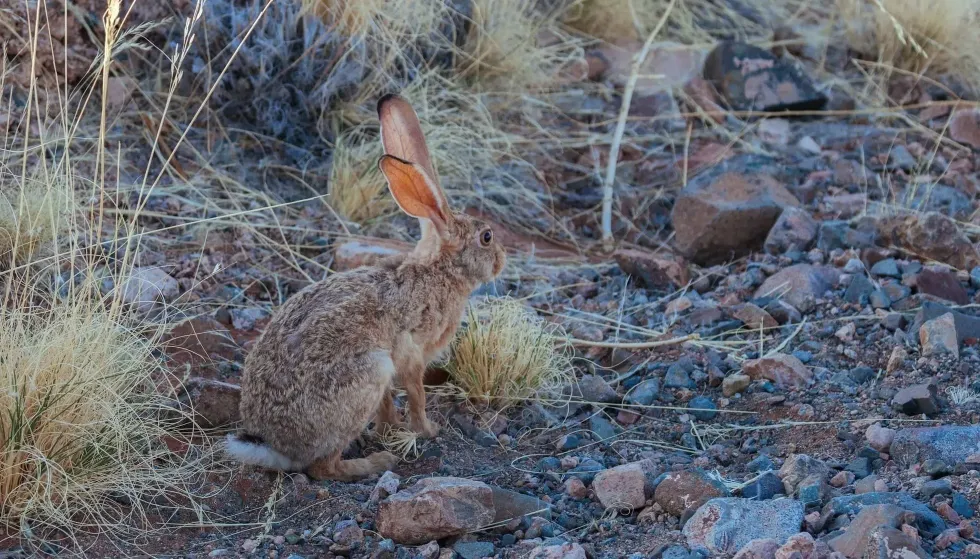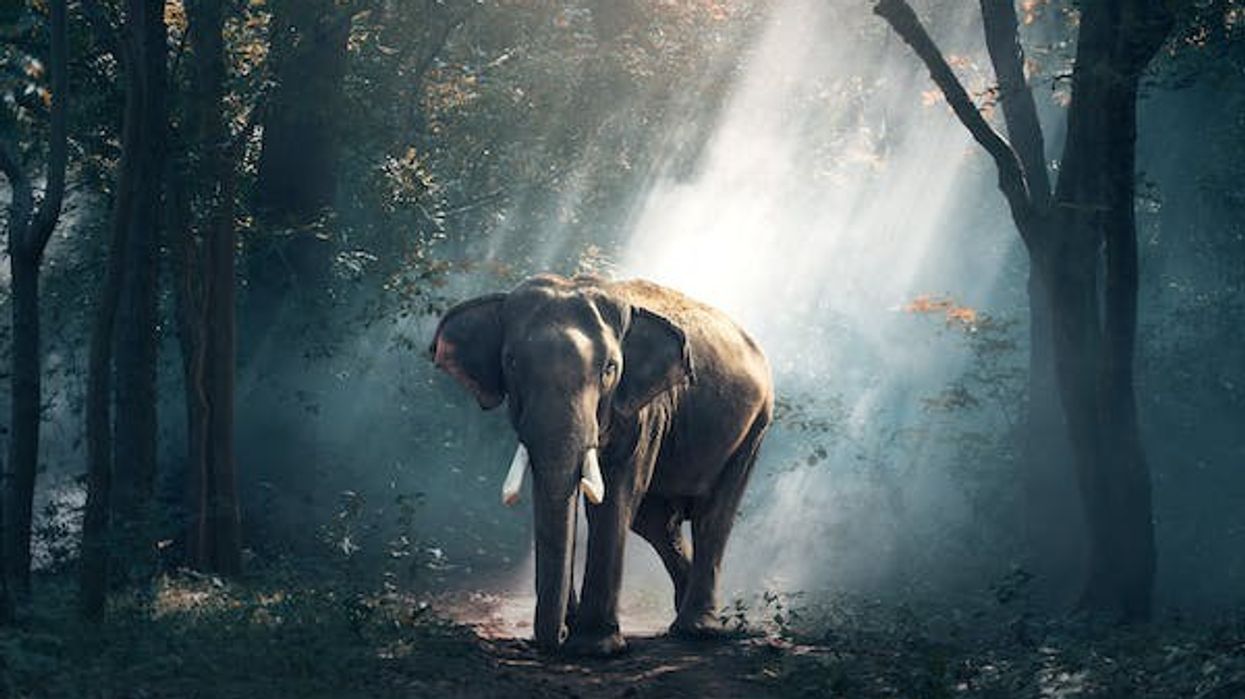The African savannah hare is a nocturnal animal species with thick brown fur and a short tail. They are from the phylum Chordata and the order Lagomorpha.
Similar to the relative species of cape hares, which are often known as desert hares, these African animals also have mobile ears which are very long. It almost appears as if their ears are longer than their body!
Their hind legs are used to communicate. Their sharp incisors help to cut and chew vegetation due to their distinctive groove pattern that distinguishes this hare from cape hares.
They eat fruit and their habitat is mainly savannas. They have a rich body color which most other hares do not have and the tail is dark black and white.
To gain more nutrients, they eat their ownfeces. They have good techniques to defend themselves from predators and this is helping to maintain their conservation status of Least Concern.
When in danger, they run for a short distance to throw their scent and confuse the predator. The brown skin tone and sense of smell give them an edge to be safe.
Have an interest in mammals and want to know about more of them? Here you can know some amazing facts about the snowshoe hare and brown hare!
African Savanna Hare Interesting Facts
What type of animal is an African savanna hare?
The African hare is a type of rabbit with sharp teeth and a strong scent, native to the southwestern Palearctic and Ethiopian biogeographic regions. This mammal prefers the dry habitats of Africa.
What class of animal does the African savanna hare belong to?
This species belongs to the Mammalia class, order Lagomorpha, and genus Lepus. Their scientific name is Lepus victoriae. Their soft brown skin was used for clothing by humans in the past.
How many African savanna hares are there in the world?
There is no exact number of how many African hares there are in the world. Right now, their population is abundance in most countries of Africa. The African hare eats roots, fungi, and bark and it also has a really good sense of smell.
Where does the African savanna hare live?
This hare species prefers to live in burrows in the habitat of open grasses.
These hares are very common in Old World countries of Africa like Morocco, South Africa, Mauritania, Somalia, Tunisia, Libya, the Democratic Republic of Congo, Botswana, Ethiopia, Senegal, Guinea-Bissau, Burundi, the Gambia, Algeria, Chad, Sierra Leone, southern Mozambique, Rwanda, Ghana, south Mali, Niger, Guinea, Namibia, Tanzania, Sudan, Kenya, Uganda and Zambia.
What is an African savanna hare's habitat?
The African savanna hare habitat consists of regions of savannas and Sahel. They prefer to build burrows for litter in a range of natural habitats of scrubby grasslands, montane areas, woodlands, wooded steppes, cultivation mosaics, and montane grasslands.
They also like to live in kangaroo grasses like camphor bushes and cogon grasses. They prefer those regions where the grasses grow easily after a wildfire.
Who does the African savanna hare live with?
African savanna hares are solitary creatures and do not like to interact with others. These animals can be seen feeding in very small groups.
This species rarely is seen during the day because they are mostly active at night. They often make drumming noises with their hind feet as an alarm signal to alert other group mates of danger. These hares often fight and chase each other, especially during mating time.
How long does an African savanna hare live?
The average life of this solitary mammal is two to eight years, though the longest life of an African hare ever recorded in the world is 12.5 years.
How do they reproduce?
This species des not have any particular breeding season. The breeding season continues throughout the year, but the pregnancy in females is least successful in the fall season. The gestation period is between 25-30 days and the female gives birth to kits throughout the year.
They have a litter size of six to eight kits. The mother mostly gives birth to at least 14 kits every year.
The babies born are fully haired and can run very well straight after birth. The mother separates herself from the newborn after a very short interval of giving birth and spends very little time suckling. They do so to avoid the attention of predators in the wildlife.
What is their conservation status?
According to the IUCN Red List of the International Union for Conservation of Nature (IUCN), the conservation status of the African hare is Least Concern.. They do not have any special status in the CITES, US Federal List and State of Michigan List. They are in abundance that in Africa, their population range is 44 rabbits per acre/hectare.
African Savanna Hare Fun Facts
What does the African savanna hare look like?
African savanna hares tend to have a rusty brown, medium-sized body and are nocturnal. Their tails are very short and are black from above and white from below.
These hares tend to have a richer body color than many hares and their back is gray-brown. They have a white dorsal and a russet hue on the nape of the neck, breasts, and feet. They have very long ears with black tips.
Their limbs and flanks are red-brown in color, while the underparts are whitish. They are look similar to the Tolai hare.
How cute are they?
The African hare has fur all over its body and also is not too big in size. They are very cute creatures but it is very tough to keep sight of them as they run so fast.
How do they communicate?
African savanna hares have good hearing, smell, and sight. They escape as soon as they see predators approaching them. Their long ears help in signaling.
Their nostrils have a sensory pad that has hairs at the entrance and helps in olfaction. To give a warning to other hares in the group, they drum with their feet.
They also use teeth-griding as a warning. A female hare also makes a bleating call to her young ones. The sounds which they make are almost inaudible to human ears but their long ears detect them easily.
How big is the African savanna hare?
This open grassland species of African hares are 16-23 in (41 -58 cm) long.
How fast can an African savanna hare run?
This African hare cannot see what is in front of them directly, but it can reach good speeds. Their running motion is zig-zag. This rabbit can reach speeds up to 43 mph (70 kph).
How much does an African savanna hare weigh?
The weight of these rabbits is 3.3-6.6 lb (1.5-3 kg). Their weight is one of the lightest weights of hares.
What are the male and female names of the species?
As cute as these hares are, their male and female names are equally cute. Male hares are called jacks and female hares are called jills.
What would you call a baby African savanna hare?
A newborn baby African hare is called a leveret.
What do they eat?
These hares are herbivores and mainly feed on grasses and herbs as part of their diet as they a lot of nutrients from these items. The African Savanna Hare diet also consists of fruit, berries, roots, fungi, bark, leaves, twigs, and buds.
They tend to eat their food twice as their diet causes them to hvae two types of dropping. The feces which they excrete at night contains nutrients and undigested plant matter.
The feces which they excrete during the day is a total waste and they do not eat them. They eat the night feces as part of their diet.
Are they dangerous?
Hares are kind of shy and like to be in solitude. They do not like to interact too much with humans unless they are in a suitable environment. They feel threatened by us and will run away as soon as we try to go near them or approach them in any way.
Would they make a good pet?
There are not many cases where these African hares are kept as pets by human beings. There are some breeds of rabbits that can make excellent pets, such as the Rhinelander rabbit.
Did you know...
One of the amazing facts about their breeding system is that the female can reabsorb the embryo if it faces a food shortage or any external crisis.
Is the African savanna hare endangered?
No, the African hare is not endangered. They are under the Least Concern status of the IUCN and can be very easily seen in the wildlife of Old World countries. In the past few years, the population range of these hares has been decreasing rapidly due to increased human settlements, fencing of land, and ranching.
What animal eats African savanna hares?
Though hares run very fast, the chance of being caught by other animals is quite high. African savanna hare predators are snakes, birds of prey, owls, hawks, big carnivorous birds, and coyotes which prey on them. They are not always the first choice for these predators.
Here at Kidadl, we have carefully created lots of interesting family-friendly animal facts for everyone to discover! For more relatable content, check out these mountain hare facts and Arctic hare facts for kids.
You can even occupy yourself at home by coloring in one of our free printable African savanna hare coloring pages.









